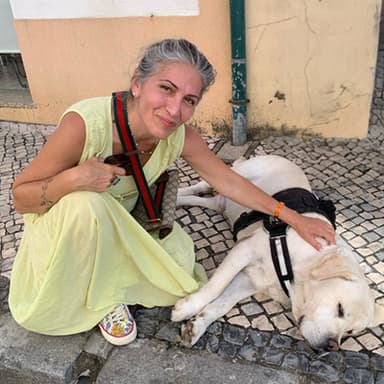How to Build Trust With Your New Dog
If life with your new rescue isn’t picture-perfect, don’t worry. Here are some actionable strategies to get you and your BFF on the path towards bonding.
If life with your new rescue isn’t picture-perfect, don’t worry. Here are some actionable strategies to get you and your BFF on the path towards bonding.
by Vivian Zottola, MSc, CBCC, | December 13, 2024

Pansfun Images / Stocksy
Building trust with a new dog is a journey that requires patience, commitment, and realistic expectations. Just as forming a new friendship with a person takes time, so does building a bond with a dog. Ultimately, you’ll discover their likes and dislikes, share positive experiences, and gradually build a solid trusting relationship.
The basic needs we are expected to provide our rescue dogs include access to food, clean water, regular veterinary care, potty breaks, mental/physical exercise, play, and social exposure to other animal friends. But it’s also your responsibility as an adopter to prioritize safety, satisfaction, and joy — which all dogs seek — especially when introducing them to a new home and new people. Remember, the joy and satisfaction that comes from caring for a rescue dog is immeasurable. By doing so, we help them learn to trust.
Let’s explore, in more detail, how to establish trust with your new dog.
While it may seem counterintuitive, giving your new rescue dog some space and independence — if that is what they desire — can actually strengthen the bond between you. Begin by establishing consistent routines for feeding and playtime, because this helps your dog feel secure. When they’re ready to engage, several activities can improve the relationship between new dogs and their adopters. According to the Human Animal Bond Research Institute, here are some of the most effective ones.
Training: Behavior training focuses on establishing clear communication regarding desirable dog behaviors and is particularly beneficial for rescue dogs who may be uncertain about their new home. It promotes the use of praise and rewards — such as treats, toys, or affection — when the dog problem-solves or does desired behaviors. Focusing on what a rescue dog does right helps provide clear direction, reduces distress, and successfully promotes repeated preferred behavior in the long term.
Decompression walks: Most dogs love being outdoors to smell, explore their surroundings, and interact with other dogs — which is essential for learning and maintaining social skills. That said, if your dog would rather not be around other dogs, go for a hike, by the beach or find an open area to explore together.
Dog sport training: Engaging in games like agility, rally, trick training or nose work with your dog enhances teamwork and strengthens your bond.
Grooming: Regular grooming sessions, with their calming effects, not only help a dog get used to being handled, but also provide a relaxing experience for their person.
Quality time: Whether cuddling or going on adventures, spending time together builds emotional connections.
Mental stimulation: Challenging activities such as scent work have been shown to keep a dog happy and mentally sharp.
Regular exercise: Walking and playing fetch keep dogs healthy and promote bonding.
Socialization: Socialization is essential and requires you to be mindful of your dog’s comfort level and safety. As your dog develops more confidence and becomes ready to meet people and other dogs in controlled environments, they will look to you for guidance, trusting that you know what is best for them.
Structured play: Games like tug-of-war and puzzle toys mentally engage them, creating shared experiences and fun memories.

Recognizing a dog’s stress responses and anticipating their needs — i.e. addressing their fears proactively — is crucial for building trust. This approach demonstrates that you are a responsible and caring caregiver, which ultimately strengthens their relationship with you. Understanding a dog’s baseline behavior is the first step in spotting (and helping them with) their fears.
One of the best ways to determine if a dog is scared, stressed, or anxious is by observing their baseline behavior, or how they act in different situations when they’re not overly excited or fearful. This will help you recognize when your dog is stressed or uncomfortable.
A baseline behavior assessment offers several benefits.
Health: Sudden changes in behavior can be an early sign of medical problems, including pain, illness, and cognitive decline. Underlying pain is frequently a primary cause of challenging behavior in dogs.
Safety: Knowing how a dog responds to environmental changes can help prevent potential conflicts and accidents, so it’s important to provide the dog with a safe space and prepare in advance for their arrival into your home.
Effectiveness of management: A baseline informs you if changes made in the surroundings work better for the dog’s needs.
Effectiveness of behavior training: Training programs should always be rooted in science and kindness. A behavior assessment helps trainers choose the most effective, humane training strategies.
Resilience: Measuring improvements is easier when you have a baseline to go by.
Communication: Understanding baseline behaviors helps a new guardian interpret signals accurately, leading to improved communication and trust building.
Below are key behaviors to observe. When evaluating behaviors, consider scoring them from one (relaxed and comfortable) to five (high stress or fear). This can help you track progress and share insights with a veterinarian, behavior consultant, or trainer.
Rate the following, from 1 (not really) to 5 (very much so).
Gaze: The dog is uncomfortable looking at a person’s face and avoids eye contact.
Personal space: If you lean into their space, the dog moves or looks away.
Sound association: They respond to noises inside and/or outside the home by hiding or otherwise withdrawing.
Food association: The dog does not gently take treats from you. Or, after picking up the treat or bone, walks away (i.e., they do not hang out with you).
Being held: They struggle to get away or are uncomfortable being held.
Reaction to toys: The dog does not enjoy playing with objects like balls or squeaky toys.
Reaction to new things: They startle or get stiff when they hear an unfamiliar noise or see an unfamiliar object, unfamiliar person, or unfamiliar animal.
Reaction to surfaces: The dog does not walk easily on grass, cement, tile, or marble floors.
Separation response: When you leave the room or leave them at home, they bark or whine, pace, tremble, or drool excessively.
Body posture: They are not able to relax and are constantly moving about.
When evaluating dog behaviors, a rating of one indicates a more relaxed and comfortable (and trusting) dog, while a rating of five signifies high stress or fear. Once you’ve gauged these behaviors, it’s important to create a plan to keep your rescue dog feeling safe, as they learn to adjust. This proactive approach not only ensures their well-being but also strengthens your bond with them.
Rescue dogs often have unknown histories, so you need to be slow and patient in your approach. Moving into a new home can be overwhelming and disorienting for many dogs. Because everything around them is unfamiliar, they may experience feelings of uneasiness. To help a rescue dog adjust, focus on their comfort and give them space. Make sure to approach them on their terms. Respecting their boundaries is one of the most important steps in building trust.
If your dog doesn’t respond to treats, they may just need something different. Consider changing the treats to something more appealing, such as real meat or a new protein source. If you think your dog is full after eating, try other rewards, such as toys, praise, or playtime. But if your dog usually responds to treats and suddenly isn’t interested — and they haven’t just eaten — they could be nervous about something in their environment. Take a moment to assess the surroundings from their perspective.
Absolutely. It’s common for a newly adopted dog to feel some level of apprehension as they adjust to a new environment and different routines. With time, patience, and positive reinforcement, most dogs will gradually become more comfortable and confident in their new surroundings. If they seem excessively overwhelmed, speak with your veterinarian about your concerns, and they can direct you to the right professional.
Helping a scared dog feel secure starts with being mindful of your body language and how your movements may affect them. For instance, leaning into a dog’s space, making direct eye contact, or touching them before they’re ready may cause the dog to retreat in fear. Instead, adopt non-threatening body language (such as turning your face and body slightly to the side or averting your gaze) to help a scared dog feel less intimidated. This behavior mimics how dogs communicate with one another when they have non-threatening intentions.
When dealing with a fearful dog, do not force interactions with people or other animals. Avoid punishing a fearful dog, and instead use kind, soothing words and positive reinforcement. Avoid loud voices, harsh movements, or forced engagements that overwhelm them. Instead, gradually expose them to new situations. While providing a fearful dog with a safe space in the home is important, avoid isolating the dog — having a family member nearby can offer comfort and reassurance.
“5 Tips for Successful Dog Training.” Vetmed.vt.edu, vetmed.vt.edu/news/2023/dog-training-tips.html.
“Dog Behavior Tips.” King County, www.kingcounty.gov.
Flom, Ross, and Peggy Gartman. “Does Affective Information Influence Domestic Dogs’ (Canis Lupus Familiaris) Point-Following Behavior?” Animal Cognition, vol. 19, no. 2, 29 Oct. 2015, pp. 317–327, https://doi.org/10.1007/s10071-015-0934-5. Accessed 17 June 2019.
“Shy and Fearful Dogs.” Metropolitan Government of Nashville & Davidson County, nashville.gov.

Vivian Zottola, MSc, is an applied anthrozoologist, dog psychologist, member of the Dog Writers Association of America, and research associate with the Center for Canine Behavior Studies, Inc. She runs her own practice in Boston, MA, specializing in the prevention and resolution of behavior challenges between humans and pet companion dogs. She also produces the podcast Click Therapy for Dogs and the People Who Love Them. Find her on Instagram.

Adoption Advice

Behavior & Training

Behavior & Training

Adoption Advice
Stray dogs often thrive in new homes, but proper preparation and patience are key to a smooth transition

Adoption Advice
With the right care, puppy mill rescues can learn to trust and thrive.

Behavior & Training
Is your dog bent on destroying everything in sight? (We know the feeling.) Here are the best ways to stop this destructive behavior.

Shelters & Rescue
This simple act can greatly benefit shelter pups (and humans, too).

Foster & Volunteer
Fostering comes with important responsibilities. Learn which shelter or rescue is right for you by asking these key questions.

Behavior & Training